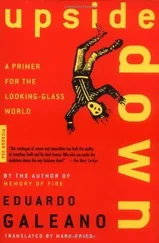In Chicago, General Miles solved the worker problem by sending the leaders of the Pullman strike to their graves.
In San Juan, Puerto Rico, General Miles solved the colonial problem by pulling down the Spanish flag and raising the Stars and Stripes in its place. And he nailed up posters all over town that said, “English spoken here,” in case no one had noticed. He proclaimed himself governor. And he explained to the invaded that the invaders had “come not to make war, but on the contrary, to bring you protection, not only to yourselves, but to your property, and to promote your prosperity, and to. . ”

From the beginning, the redemption of the Philippines enjoyed the invaluable support of the ladies of charity.
Those good souls, wives of high officials and officers of the invading forces, began by visiting the Manila jail. They noticed that the prisoners were markedly thin. When they toured the kitchen and saw what the wretches were eating, their hearts sank. It was primitive rice: grains of all sizes, opaque, dark, with the husk and germ and everything still attached.
They implored their husbands to do something, and their husbands did not pass up the chance to do good. The next ship from the United States brought a cargo of civilized rice, all the grains alike, husked and polished and shining, whitened with talcum powder.
From the end of 1901, that is what the prisoners ate. In the first ten months, 4,825 of them fell ill, and 216 died.
American doctors attributed the disaster to one of those microbes that propagate in the poor hygiene of backward countries. But just in case, they ordered the prison kitchen to go back to the old menu.
Once the prisoners were eating primitive rice again, the plague disappeared.

In 1889, Brazil’s monarchy died suddenly.
One morning, monarchist politicians woke up as republicans.
A couple of years later, the constitution established universal suffrage. Everyone could vote, except women and the illiterate.
Since nearly all Brazilians were either female or illiterate, practically no one voted.
In the first democratic election, ninety-eight of every one hundred Brazilians did not answer the call to the ballot box.
A powerful coffee baron, Prudente de Moraes, was elected the nation’s president. He moved to Rio from São Paulo and nobody noticed. No one came out to greet him; no one even recognized him.
Now he enjoys a certain renown as the main street near the elegant beach of Ipanema.

In colonial times, those Brazilian families who could afford the luxury sent their sons to study at the University of Coimbra in Portugal.
Later on, several schools were set up in Brazil to train lawyers and doctors: few of either, since potential clients were scarce in a country where the many had neither rights nor any medicine but death. Several schools, but no university.
Until 1922. That year Belgium’s King Leopold III announced plans to visit the country, and such an august presence merited a doctor honoris causa, which only a university could bestow.
Thus the university was hurriedly concocted and installed in a rambling old house occupied by the Imperial Institute of the Blind. Sadly, the blind had to be evicted.
And thus Brazil, which owes the best of her music, her soccer, her food, and her joy to blacks, gave an honorary doctorate to a king whose only merit was his membership in a family that specialized in exterminating blacks in the Congo.

Montevideo was not always gray. It was grayed.
Back around 1890, a traveler who visited Uruguay’s capital could still pay homage to “the city where bright colors triumph.” The houses that faced the street were red, yellow, blue. .
Shortly thereafter, those in the know explained that such a barbaric custom was not proper for a European nation. To be European, no matter what the map said, one had to be civilized. To be civilized, one had to be serious. To be serious, one had to be sad.
And in 1911 and 1913, municipal ordinances specified that paving stones for sidewalks had to be gray and that “only paint that imitates the construction materials, like sandstone, brick, or stone in general, will be allowed” on street-facing facades.
Painter Pedro Figari mocked this example of colonial stupidity: “Fashion insists that even the doors, window-frames, and sunshades be painted gray. Our cities aspire to be like Paris. . Montevideo, luminous city, is sullied, crushed, castrated. . ”
And Montevideo succumbed to copyitis.
Even so, during those years Uruguay’s creative energies made it the epicenter of Latin American audacity. The country had free secular education before England, women’s suffrage before France, the eight-hour day before the United States, and legal divorce seventy years before it was restored in Spain. President José Battle, “Don Pepe,” nationalized public services, separated church and state, and changed the names of holidays. In Uruguay, Easter is still called Tourism Week, as if Jesus had the misfortune to be tortured and killed during his week off.

The painting made Édouard Manet famous is of a typical Sunday scene: two men and two women having a picnic on the grass on the outskirts of Paris.
Nothing out of the ordinary, save one detail. The men, impeccable gentlemen, are fully clothed and the women are completely naked. The men are discussing some serious topic, as men are wont to do, and the women are about as significant as the trees around them.
The woman in the foreground is looking at us. Perhaps she is asking, “Where am I? What am I doing here?”
Women are but decoration, and not only in the painting.

Aristotle knew what he was talking about:
“A woman is like a deformed man. She lacks an essential element: a soul.”
Painting and sculpture were forbidden kingdoms for the beings without souls.
In sixteenth-century Bologna, there were five hundred and twenty-five painters, one of whom was a woman.
In the seventeenth century, the Académie des Beaux-Arts of Paris had four hundred and fifty members, fifteen of whom were women, all of them wives or daughters of male painters.
In the nineteenth century, Suzanne Valadon was a market vendor, a circus acrobat, and a model for Toulouse-Lautrec. She used corsets made of carrots and shared her studio with a goat. That she was the first woman who dared to paint male nudes surprised no one. She had to be nuts.
Erasmus of Rotterdam also knew what he was talking about:
“A woman is always a woman, in other words, crazy.”

The family declared her insane and had her committed.
Camille Claudel spent the last thirty years of her life in an asylum, held captive.
It was for her own good, they said.
In the asylum, a freezing prison, she refused to sketch or sculpt.
Читать дальше



















